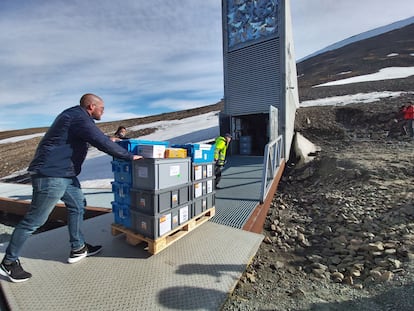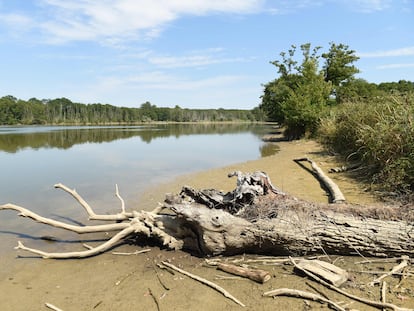The bunker at the end of the world: Why the salvation of humankind is in Norway
Bombproof and able to withstand massive earthquakes, the Svalbard World Seed Vault is a Noah’s Ark designed to safeguard global food supply in case of a catastrophe

Just 800 miles from the North Pole, on the island of Spitsbergen in the Norwegian archipelago of Svalbard, underground and bombproof, is a facility that has been dubbed the bunker at the end of the world, or the Noah’s Ark of seeds. Officially it is called the Svalbard World Seed Vault, and it holds over a million varieties of 6,000 plant species that grow in every climate and on every continent on the planet. The objective of this storage facility is to ensure that humankind can continue to produce food in the event of a catastrophe.
According to the Food and Agriculture Organization of the United Nations (FAO), of 6,300 livestock breeds catalogued on Earth during the 20th century, only 1,300 have survived. In the case of plant species, over the same timeframe 75% have disappeared and two out of every three are in danger of extinction. On paper, there are over 400,000 species of vascular plants – those with roots, stems and leaves – of which only between 8,000 and 10,000 have been used over the centuries for food production. However, global food supply essentially comes from about 200 seeds. Of that number just nine - sugarcane, maize, wheat, rice, potato, soybean, palm, beet and cassava - account for two thirds of the world’s total food production from agricultural activity.
This massive dependency on so few species, together with the progressive erosion of biodiversity based on a foundation of thousands of traditional species, sparked concern in the 1980s among international organizations such as the FAO and the World Bank, who recognized the need to safeguard the availability of seeds to ensure food supply for a world population that stands at eight billion people today, but which is expected to rise to 10 billion by 2050. As such, the FAO put forward the idea of creating a world seed bank where all the associated global institutions, some 1,500 of them, can store a backup copy of their varieties with access to them whenever necessary. In this sense, the World Seed Vault acts much like a safe does in a bank.
José Esquinas, an agricultural engineer and genetics expert, joined FAO in 1978 where he has served as Secretary of the Intergovernmental Commission on Genetic Resources for Food and Agriculture for 30 years. Esquinas was one of the driving forces behind the initiative to build a depository for the protection of seeds and biodiversity. Although there were many candidates to host the facility, in 2008 it was decided that it would be built in Svalbard.
The Noah’s Ark of seeds aims to ensure its stock maintains useful permanence for two centuries, even if its refrigeration units fail. It is located 130 meters inside an old sandstone mine and 130 meters above sea level, with constant temperature of -18 degrees Celsius (-0.4°F). The facility is spread over an area of about 1,000 square meters, divided into various different chambers, with almost no light. The seeds – about 500 per batch and dehydrated to 5% humidity – are kept in envelopes wrapped with several layers of aluminum foil and stored in boxes upon which their species and other information is recorded.
The World Seed Vault is owned by the Norwegian state and required an initial investment of €9 million, to which another €20 million was added to eliminate humidity. Annual maintenance comes in at around €1 million. It is financially supported by the FAO, together with institutions and foundations such as the Global Crop Diversity Trust and the Bill and Melinda Gates Foundation.
The facility has been constructed to withstand volcanic eruptions and earthquakes measuring up to 10 on the Richter scale, and the surrounding area has been declared a demilitarized zone. Since it was opened, more than a million varieties of seeds have been deposited by 86 countries and institutions, representing nearly 6,000 species. To date, the only institution that has returned to its deposit at the bank has been the International Center for Agricultural Research in the Dry Areas (ICARDA), after 148,000 varieties stored at its warehouse in Aleppo, Syria, were destroyed as a consequence of the civil war. ICARDA had sent duplicates of 80% of its seeds to Svalbard. In 2015, the organization withdrew 50,000 varieties for planting and, once these were collected and its own supplies replenished, it sent another 50,000 seeds of the same varieties back for storage.
Esquinas notes the “threat” posed to the world by the loss of biodiversity in the world due to the small numbers of species used and the prevalence of varieties that have been adapted to environmental conditions. He also warns of the risks posed by the fact that today, global food supply is linked to the commercial sale of no more than 150 seeds, which he describes as a “barbarity.” As the expert points out, these varieties are very uniform and stable and better-adapted to withstand the use of pesticides, insecticides or agrochemicals but, for precisely the same reason, they are vulnerable to attacks by disease, cold or drought that could wipe them out: this is not the case with other varieties that have adapted to climate change. In this context, Esquinas warns that loss of diversity and increases in the use of these newer seed supplies has resulted in a more productive agriculture, but also one that is much more vulnerable.
Sign up for our weekly newsletter to get more English-language news coverage from EL PAÍS USA Edition
Tu suscripción se está usando en otro dispositivo
¿Quieres añadir otro usuario a tu suscripción?
Si continúas leyendo en este dispositivo, no se podrá leer en el otro.
FlechaTu suscripción se está usando en otro dispositivo y solo puedes acceder a EL PAÍS desde un dispositivo a la vez.
Si quieres compartir tu cuenta, cambia tu suscripción a la modalidad Premium, así podrás añadir otro usuario. Cada uno accederá con su propia cuenta de email, lo que os permitirá personalizar vuestra experiencia en EL PAÍS.
¿Tienes una suscripción de empresa? Accede aquí para contratar más cuentas.
En el caso de no saber quién está usando tu cuenta, te recomendamos cambiar tu contraseña aquí.
Si decides continuar compartiendo tu cuenta, este mensaje se mostrará en tu dispositivo y en el de la otra persona que está usando tu cuenta de forma indefinida, afectando a tu experiencia de lectura. Puedes consultar aquí los términos y condiciones de la suscripción digital.
More information

The struggle to save the last mermaids of Africa
Últimas noticias
All the effects of gentrification in one corner of Mexico’s Colonia Roma
Palestinian reporter Youmna El Sayed: ‘My family told me I had to choose between being a journalist or a mother’
‘Sleepless City’: The light of cinema illuminates Madrid’s Cañada Real shantytown
The new language of the workplace: Knowing how to ask AI questions is more important than using it
Most viewed
- The low-cost creative revolution: How technology is making art accessible to everyone
- Christian Louboutin: ‘Young people don’t want to be like their parents. And if their parents wear sneakers, they’re going to look for something else’
- US sanctions against jailed cartel leader ‘El Marro’ highlight Mexico’s lack of control over its prisons
- Liset Menéndez de la Prida, neuroscientist: ‘It’s not normal to constantly seek pleasure; it’s important to be bored, to be calm’
- ‘El Limones’ and the growing union disguise of Mexican organized crime









































